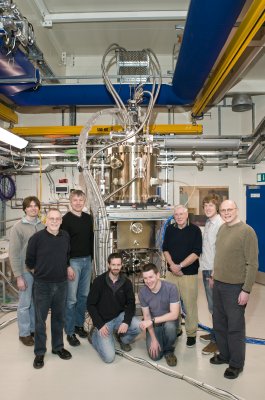Oxford Instruments has recently installed a state-of-the-art 14 Tesla superconducting magnet system for ultra-high-vacuum experiments at Diamond Light Source, the UK's national synchrotron facility.
The magnet system has been installed on the new I10 Beamline for Advanced Dichroism Experiments (BLADE) and has already been used by the first researchers to search for "hidden magnetic states". If found they will provide important confirmation of a theoretical model which would have important applications in magnetic data storage.

The new magnet system required several months to build and install due to the high level of integration with Diamond equipment and the innovative steps within the magnet and system design to meet the experimental needs. To allow fast ramping of the magnetic field, the 14 Tesla, horizontal field split pair magnet was constructed using Oxford Instruments' innovative low-hysteresis Nb3Sn superconducting wire, developed by Oxford Superconducting Technology (OST) as part of its contract to supply 58 tonnes of wire to the ITER project.
As a result, the magnet can be swept from -14 T to +14 T in less than an hour, a significant achievement in itself. Since the magnet has to operate in an ultra high vacuum (UHV) environment, directly connected to the Diamond beamline, its construction required the specific UHV cleaning and build processes and facilities which Oxford Instruments has developed over some years. The system is thus fully UHV compatible and has been designed to be baked. A UHV Variable Temperature Insert (VTI) integrated with the system offers sample temperatures from 2 K to 420 K.
Finally, the magnet is contained in a cryostat which fully recondenses all of the liquid helium, using twin pulse tube refrigerators to re-liquefy the evaporating helium gas. Because the magnet system is fitted with the latest high temperature superconducting (HTS) magnet current leads which minimise thermal input, the liquid helium continues to be recondensed even during magnet sweeping.
Dr Peter Bencok, Senior Beamline Scientist on BLADE, commented: "We are very happy to have received this new high-field superconducting magnet. The first results are very promising and represent an important milestone, not only for the beamline, but for the whole of Diamond. Its magnetic field of 14 Tesla is 300,000 times stronger than the earth's magnetic field, and about six times stronger than the saturation magnetization of high purity iron. It will also record the lowest temperature at Diamond of 300 milliKelvin - a chilling minus 272.85 degrees Celsius. The team has worked hard to achieve this milestone and we are really pleased to see that BLADE is playing a key role in important new physics."
Dr John Burgoyne, Business Manager of the Magnet Systems Group at Oxford Instruments says: "Working with customers at the leading edge of science and technology such as Diamond Light Source, constantly drives and challenges our own technology development, and continuously enhances our expertise in advanced superconducting magnet systems. In particular, this system even further strengthened our expertise in high field recondensing magnet systems for beamline applications, and in UHV system design and build.
We feel privileged to have had the opportunity to work closely with the Diamond team, and be a part of the UK and local economy which both supports and benefits from this world-class science base in the UK".